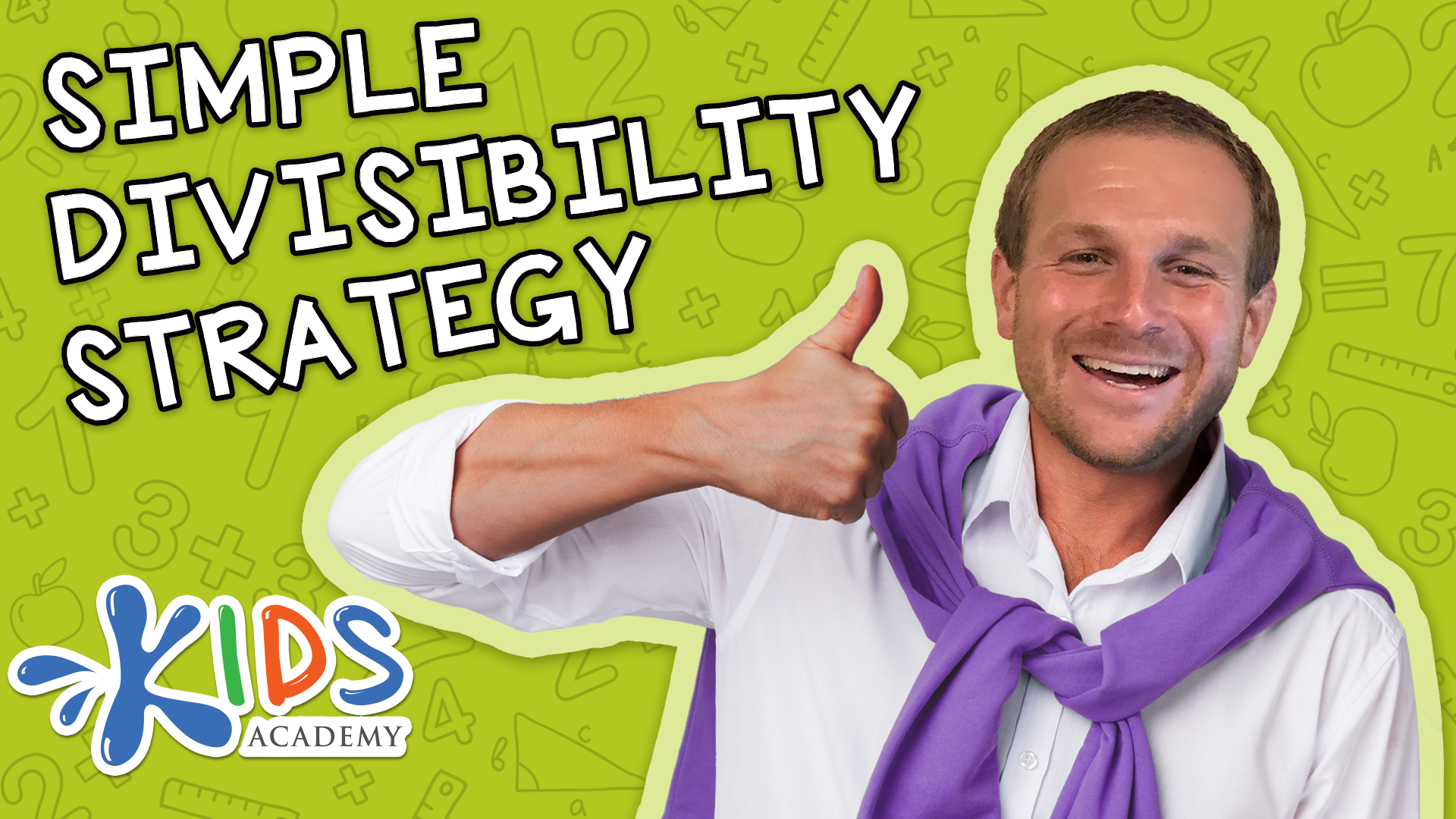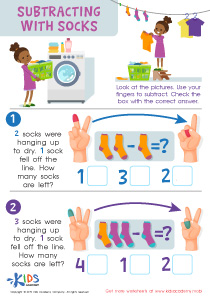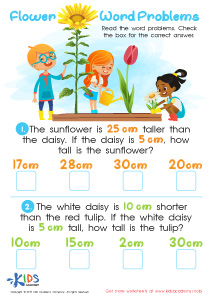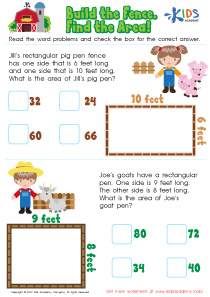Time Word Problems Worksheets for Ages 8-9
1 filtered results
-
From - To
Introduce your child to our Time Word Problems worksheets, specifically designed for ages 8-9. These learning interactive worksheets offer a fun and engaging way to master the essential skills of telling time and solving time-related questions. Each sheet is crafted to challenge young minds while reinforcing their understanding through practical, real-world scenarios. With a variety of puzzles and problems, these worksheets ensure a comprehensive grasp of time concepts, enhancing both cognitive and problem-solving skills. Perfect for home or classroom use, our worksheets make learning about time exciting and productive for young learners. Equip your child with the tools for success in everyday tasks and future mathematical concepts!
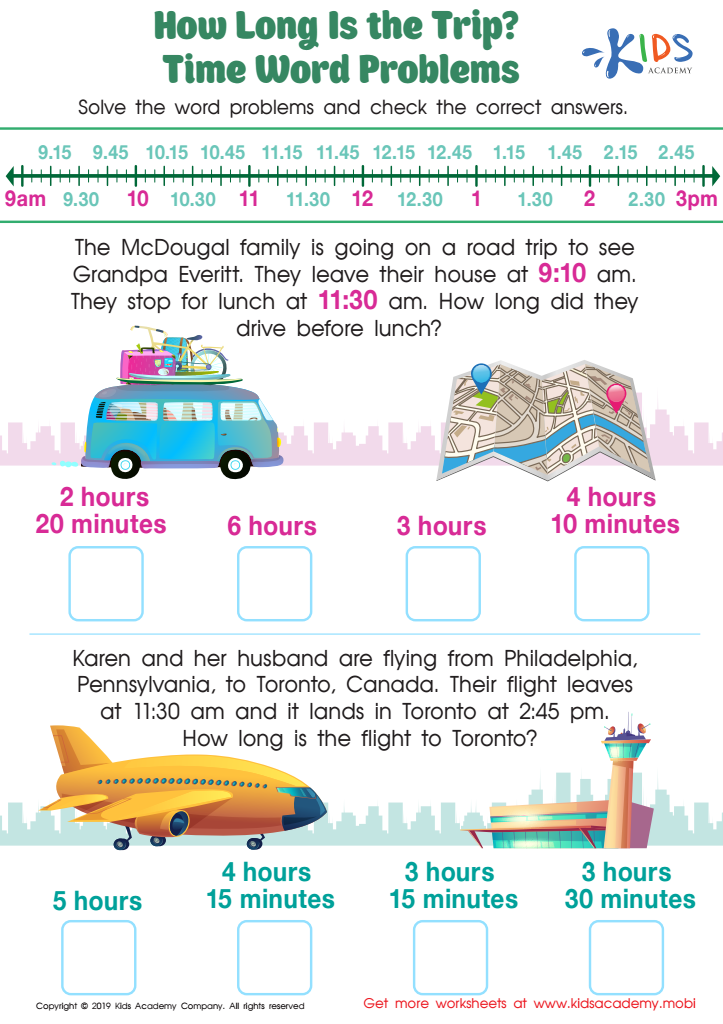

How long is the Trip? Time Word Problems Worksheet
Unlocking Time Mastery: The Benefits of Learning Interactive Printables for Time Word Problems
As children grow and explore the world, their understanding of time not only enhances their daily life skills but also deepens their academic abilities. For 8-9-year-old students, grasping the concept of time is crucial, and one effective tool to aid this learning process is through worksheets focused on Time Word Problems. These learning interactive printables are designed to engage young minds in a fun and educational way, ensuring that they not only learn but also enjoy the process.
Why Are Time Word Problems Worksheets Beneficial?
1. Enhancing Problem-Solving Skills: Time Word Problems worksheets challenge children to apply their knowledge of hours, minutes, and seconds in practical scenarios. By solving problems that require them to calculate durations, understand schedules, or convert units of time, children enhance their analytical and reasoning skills. These skills are essential not just academically but in everyday decision-making and problem-solving.
2. Building Mathematical Foundation: Mathematics is not just about numbers; it involves understanding concepts and applying them to different situations. Time word problems help children see the relevance of mathematics in real life. Whether it's figuring out the time left until a birthday party or calculating the duration of a trip, these practical applications help solidify their numerical and calculation skills.
3. Encouraging Independent Learning: Learning interactive printables are designed to be self-guided. They often come with instructions and hints that help children work through the problems at their own pace. This fosters a sense of independence as they learn to rely on their understanding and intuition to solve problems. It’s an empowering aspect of learning that boosts their confidence and encourages a proactive attitude towards education.
4. Improving Time Management: Working through time word problems naturally instills a sense of time management. Children learn to estimate the time needed for different activities, which is a critical life skill. This not only helps in their personal life but also in managing school assignments and other extracurricular activities as they grow.
5. Interactive Engagement: Unlike traditional rote learning methods, learning interactive printables are designed to be engaging. They often include colorful graphics, real-life scenarios, and interactive elements that make learning dynamic. This type of engagement is crucial for children at this age, as it keeps them motivated and curious, leading to deeper learning and retention of concepts.
6. Supporting Diverse Learning Styles: Every child learns differently, and interactive printables cater to a range of learning styles. Visual learners benefit from charts and images that explain how time works, while kinesthetic learners can engage through activities that involve moving hands on a clock or organizing their time-based worksheets. Auditory learners might benefit from discussing the problems out loud. This inclusivity ensures that every child can find a method that resonates with them, enhancing their overall learning experience.
7. Promoting Real-World Application: Learning about time through interactive printables prepares children for real-world applications. Whether it’s reading bus schedules, planning daily activities, or understanding the timing of different events, children learn to apply these skills outside the educational context, making them more competent and self-reliant.
8. Offering Differentiated Learning Opportunities: Worksheets on Time Word Problems can be easily adjusted in difficulty to cater to the individual needs of students. For those who find certain concepts challenging, simpler problems can help build confidence, while more complex problems can be offered to those who need a higher level of challenge. This adaptability makes it easy to use the same resources to meet a wide range of educational needs within a diverse classroom.
9. Facilitating Assessment and Feedback: Teachers and parents can use these printables to assess a child’s understanding of time concepts. The completion of these worksheets provides immediate feedback to the learner about areas well understood and those needing more focus. This ongoing assessment is crucial for effective learning and progression in mathematical skills.
10. Encouraging Collaboration and Communication: While primarily designed for individual use, time word problems can also be tackled collaboratively. Working in pairs or small groups, children can discuss strategies and solutions, thereby enhancing their communication skills and learning from each other. This collaborative approach can make learning more enjoyable and less isolating, fostering a healthy educational environment.
Conclusion: Worksheets on Time Word Problems are an invaluable educational tool for children aged 8-9 years. These learning interactive printables not only make the concept of time engaging and understandable but also integrate essential life and academic skills. Through these carefully crafted resources, children not only learn about time—they learn to manage it, apply it, and communicate it, setting a strong foundation for both present learning and future endeavors.

 Assign to the classroom
Assign to the classroom
